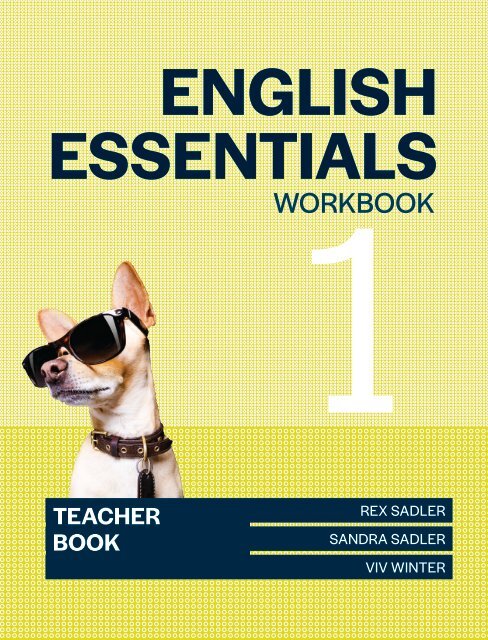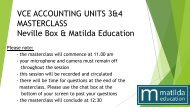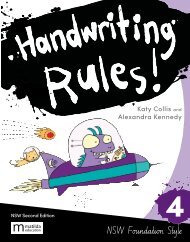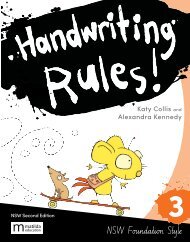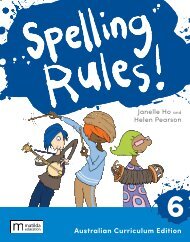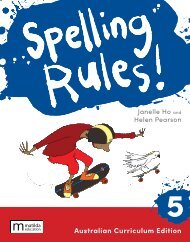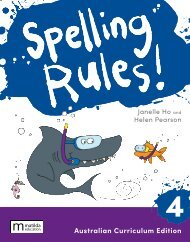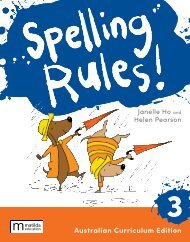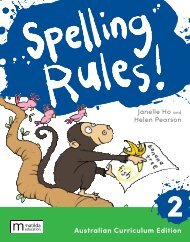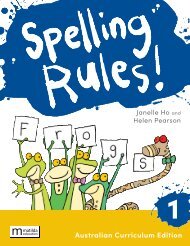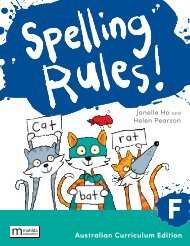English Essentials Teacher Book 1 sample
English Essentials Workbook 1 accommodates a wide range of student abilities and is suitable for both classwork and homework. The units in each section are short and self-contained, making them highly accessible and offering teachers maximum flexibility. The grammar and language units provide clear explanations of rules and conventions with carefully sequenced exercises. The texts selected for comprehension are rich and varied, while the writing tasks provide guidelines, models and photographs to help inspire students to develop their writing skills. This Teacher Book provides answers to all the comprehension, language, spelling and vocabulary questions in the student workbook.
English Essentials Workbook 1 accommodates a wide range of student abilities and is suitable for both classwork and homework. The units in each section are short and self-contained, making them highly accessible and offering teachers maximum flexibility. The grammar and language units provide clear explanations of rules and conventions with carefully sequenced exercises. The texts selected for comprehension are rich and varied, while the writing tasks provide guidelines, models and photographs to help inspire students to develop their writing skills.
This Teacher Book provides answers to all the comprehension, language, spelling and vocabulary questions in the student workbook.
You also want an ePaper? Increase the reach of your titles
YUMPU automatically turns print PDFs into web optimized ePapers that Google loves.
ENGLISH<br />
ESSENTIALS<br />
WORKBOOK<br />
TEACHER<br />
BOOK<br />
REX SADLER<br />
SANDRA SADLER<br />
VIV WINTER
ENGLISH<br />
ESSENTIALS<br />
WORKBOOK<br />
TEACHER<br />
BOOK<br />
REX SADLER<br />
SANDRA SADLER<br />
VIV WINTER
<strong>English</strong> <strong>Essentials</strong> Workbook 1 <strong>Teacher</strong> <strong>Book</strong><br />
1st edition<br />
Rex Sadler<br />
Sandra Sadler<br />
Viv Winter<br />
This edition published in 2021 by<br />
Matilda Education Australia, an imprint<br />
of Meanwhile Education Pty Ltd<br />
Level 1/274 Brunswick St<br />
Fitzroy, Victoria Australia 3065<br />
T: 1300 277 235<br />
E: customersupport@matildaed.com.au<br />
www.matildaeducation.com.au<br />
Publisher: Olive McRae<br />
Project editor: Alanna Burgess<br />
Copy editor: Ronél Redman<br />
Proofreader: Sarah Blood<br />
Design manager: Jo Groud<br />
Cover designer: Ana Cosma<br />
Text designer: Ana Cosma<br />
Production controller: Nicole Ackland<br />
Permissions researcher: Samantha Russell-Tulip<br />
Typeset in PMN Caecilia 55 Roman 10pt on 16pt<br />
by Newgen KnowledgeWorks Pvt. Ltd., Chennai, India<br />
Cover image: Shutterstock.com/Javier Brosch<br />
First edition published in 2019 by Macmillan Science and<br />
Education Australia Pty Ltd.<br />
Copyright © Rex Sadler, Sandra Sadler and Viv Winter 2019<br />
The moral rights of the authors have been asserted.<br />
All rights reserved.<br />
Except under the conditions described in the Copyright Act<br />
1968 of Australia (the Act) and subsequent amendments,<br />
no part of this publication may be reproduced, stored in<br />
a retrieval system, or transmitted in any form or by any<br />
means, electronic, mechanical, photocopying, recording<br />
or otherwise, without the prior written permission of the<br />
copyright owner.<br />
Educational institutions copying any part of this book for<br />
educational purposes under the Act must be covered by<br />
a Copyright Agency Limited (CAL) licence for educational<br />
institutions and must have given a remuneration notice<br />
to CAL.<br />
Licence restrictions must be adhered to. For details of the<br />
CAL licence contact:<br />
Copyright Agency Limited, Level 11, 66 Goulburn Street,<br />
Sydney, NSW 2000.<br />
Telephone: (02) 9394 7600.<br />
Email: memberservices@copyright.com.au<br />
Publication data<br />
Author: Rex Sadler, Sandra Sadler, Viv Winter<br />
Title: <strong>English</strong> <strong>Essentials</strong> Workbook 1 <strong>Teacher</strong> <strong>Book</strong><br />
ISBN: 9781420246193<br />
A catalogue record for this<br />
book is available from the<br />
National Library of Australia<br />
Internet addresses<br />
At the time of printing, the internet addresses appearing<br />
in this book were correct. Owing to the dynamic nature of<br />
the internet, however, we cannot guarantee that all these<br />
addresses will remain correct.<br />
Warning: It is recommended that Aboriginal and Torres<br />
Strait Islander peoples exercise caution when viewing this<br />
publication as it may contain names or images of deceased<br />
persons.<br />
Printed in by <br />
1 2 3 4 5 6 7 25 24 23 22 21 20
CONTENTS<br />
Preface ...................................................................................................................................................................................................................................................................................................................................................................... vii<br />
Acknowledgements ................................................................................................................................................................................................................................................................................................................... viii<br />
PART 1 Language 1<br />
UNIT 1 Reviewing parts of speech ................................................................................................................................................................... 2<br />
UNIT 2 Identifying nouns ......................................................................................................................................................................................................... 4<br />
UNIT 3 Types of nouns ................................................................................................................................................................................................................. 6<br />
UNIT 4 Proper and common nouns ................................................................................................................................................................ 8<br />
UNIT 5 Collective and abstract nouns ................................................................................................................................................. 10<br />
UNIT 6 Understanding sentences ................................................................................................................................................................. 12<br />
UNIT 7 Types of sentences ........................................................................................................................................................................................... 14<br />
UNIT 8 Paragraphs .......................................................................................................................................................................................................................... 16<br />
UNIT 9 Using adjectives ...................................................................................................................................................................................................... 18<br />
UNIT 10 Verbs in action ............................................................................................................................................................................................................. 20<br />
UNIT 11 Verb forms ............................................................................................................................................................................................................................. 22<br />
UNIT 12 Adverbs ....................................................................................................................................................................................................................................... 24<br />
UNIT 13 Pronouns .................................................................................................................................................................................................................................. 26<br />
UNIT 14 Prepositions ...................................................................................................................................................................................................................... 28<br />
UNIT 15 Synonyms and antonyms ................................................................................................................................................................... 30<br />
UNIT 16 Prefixes ........................................................................................................................................................................................................................................ 32<br />
UNIT 17 Suffixes ........................................................................................................................................................................................................................................ 34<br />
UNIT 18 Literal and figurative language ................................................................................................................................................ 36<br />
UNIT 19 Language revision ............................................................................................................................................................................................... 38<br />
UNIT 20 Reviewing punctuation ............................................................................................................................................................................. 40<br />
UNIT 21 End-of-sentence punctuation ................................................................................................................................................... 42<br />
UNIT 22 Capital letters for proper nouns ........................................................................................................................................... 43<br />
UNIT 23 Commas in a list or series ................................................................................................................................................................. 44<br />
UNIT 24 Commas to indicate a pause ..................................................................................................................................................... 45<br />
UNIT 25 Apostrophes – possession .............................................................................................................................................................. 46<br />
UNIT 26 Apostrophes – contractions .......................................................................................................................................................... 47<br />
UNIT 27 Quotation marks for speech ........................................................................................................................................................ 48<br />
UNIT 28 Direct and indirect speech ............................................................................................................................................................... 50<br />
iii
UNIT 29 Colons to introduce a list .................................................................................................................................................................... 51<br />
UNIT 30 Language and punctuation revision ........................................................................................................................... 52<br />
PART 2 Spelling & Vocabulary 55<br />
UNIT 1 Tricky silent-letter words ...................................................................................................................................................................... 56<br />
UNIT 2 More silent-letter words ......................................................................................................................................................................... 57<br />
UNIT 3 Confusing pairs ......................................................................................................................................................................................................... 58<br />
UNIT 4 About people .................................................................................................................................................................................................................. 59<br />
UNIT 5 Keeping up appearances .................................................................................................................................................................... 60<br />
UNIT 6 Down to the sea ....................................................................................................................................................................................................... 61<br />
UNIT 7 There’s no time like the present ........................................................................................................................................... 62<br />
UNIT 8 People at work ............................................................................................................................................................................................................ 63<br />
UNIT 9 School’s in ............................................................................................................................................................................................................................. 64<br />
UNIT 10 Places .............................................................................................................................................................................................................................................. 65<br />
UNIT 11 Speaking personally ....................................................................................................................................................................................... 66<br />
UNIT 12 Keeping fit ............................................................................................................................................................................................................................. 67<br />
UNIT 13 There’s no place like home ............................................................................................................................................................. 68<br />
UNIT 14 Survivor ....................................................................................................................................................................................................................................... 69<br />
UNIT 15 Food and drink ........................................................................................................................................................................................................... 70<br />
UNIT 16 Holiday .......................................................................................................................................................................................................................................... 71<br />
UNIT 17 Law and order .............................................................................................................................................................................................................. 72<br />
UNIT 18 The spy game ................................................................................................................................................................................................................ 73<br />
UNIT 19 Drive .................................................................................................................................................................................................................................................... 74<br />
UNIT 20 Pirates ahoy! .................................................................................................................................................................................................................... 75<br />
UNIT 21 Weather words ............................................................................................................................................................................................................ 76<br />
UNIT 22 Fantasy ......................................................................................................................................................................................................................................... 77<br />
UNIT 23 Medical matters ........................................................................................................................................................................................................ 78<br />
UNIT 24 On the ocean waves ...................................................................................................................................................................................... 79<br />
UNIT 25 Creatures great and small ................................................................................................................................................................. 80<br />
UNIT 26 Getting down to business ................................................................................................................................................................. 81<br />
UNIT 27 Puzzling pairs ................................................................................................................................................................................................................. 82<br />
UNIT 28 Around the world ................................................................................................................................................................................................... 83<br />
UNIT 29 Working with numbers ............................................................................................................................................................................... 84<br />
UNIT 30 Enrich your word power ......................................................................................................................................................................... 85<br />
UNIT 31 Fun with words ........................................................................................................................................................................................................... 86<br />
iv<br />
Contents
PART 3 Literature 87<br />
UNIT 1 Fables .............................................................................................................................................................................................................................................. 88<br />
UNIT 2 Legends ...................................................................................................................................................................................................................................... 90<br />
UNIT 3 A mysterious place ............................................................................................................................................................................................ 92<br />
UNIT 4 Meeting interesting characters ............................................................................................................................................... 94<br />
UNIT 5 Persuasive advertisements ............................................................................................................................................................. 96<br />
UNIT 6 A dangerous playground ...................................................................................................................................................................... 98<br />
UNIT 7 Cartoons .............................................................................................................................................................................................................................. 100<br />
UNIT 8 An emotional journey .............................................................................................................................................................................. 102<br />
UNIT 9 The witches ................................................................................................................................................................................................................... 104<br />
UNIT 10 Koalas in crisis ....................................................................................................................................................................................................... 106<br />
UNIT 11 Techniques of the poet ........................................................................................................................................................................ 108<br />
UNIT 12 A glimpse into the past ....................................................................................................................................................................... 110<br />
UNIT 13 Should smartphones be banned in schools? .................................................................................. 112<br />
UNIT 14 The amazing world of Lego ...................................................................................................................................................... 114<br />
UNIT 15 A memory of childhood ...................................................................................................................................................................... 116<br />
UNIT 16 Piranhas ................................................................................................................................................................................................................................ 118<br />
UNIT 17 Fantasy .................................................................................................................................................................................................................................... 120<br />
UNIT 18 Autobiography ........................................................................................................................................................................................................ 122<br />
UNIT 19 The graphic novel ............................................................................................................................................................................................ 124<br />
UNIT 20 Growing up poor ................................................................................................................................................................................................ 126<br />
UNIT 21 Fierce creatures ................................................................................................................................................................................................... 128<br />
UNIT 22 A humorous story ............................................................................................................................................................................................ 130<br />
UNIT 23 Novel to film ................................................................................................................................................................................................................. 132<br />
UNIT 24 Other lands ..................................................................................................................................................................................................................... 134<br />
UNIT 25 Animal poems .......................................................................................................................................................................................................... 136<br />
UNIT 26 A look at locks ........................................................................................................................................................................................................ 138<br />
PART 4 Writing 139<br />
UNIT 1 Self-portrait .................................................................................................................................................................................................................... 140<br />
UNIT 2 Every picture tells a story .............................................................................................................................................................. 141<br />
UNIT 3 Write about what you know ...................................................................................................................................................... 142<br />
UNIT 4 What’s your opinion? ............................................................................................................................................................................... 143<br />
UNIT 5 Writing an action scene ..................................................................................................................................................................... 144<br />
Contents<br />
v
UNIT 6 Hooking the reader ...................................................................................................................................................................................... 145<br />
UNIT 7 It’s all in the details ....................................................................................................................................................................................... 146<br />
UNIT 8 Creating an advertisement .......................................................................................................................................................... 147<br />
UNIT 9 Describing feelings and emotions .............................................................................................................................. 148<br />
UNIT 10 Setting ....................................................................................................................................................................................................................................... 149<br />
UNIT 11 Reviewing a television show ................................................................................................................................................... 150<br />
UNIT 12 In the news ..................................................................................................................................................................................................................... 151<br />
UNIT 13 Fantasy characters and creatures ............................................................................................................................. 152<br />
UNIT 14 Creating a graphic novel ................................................................................................................................................................. 153<br />
UNIT 15 Show, don’t tell! ................................................................................................................................................................................................... 154<br />
UNIT 16 An alien landscape ....................................................................................................................................................................................... 155<br />
UNIT 17 A conversation ....................................................................................................................................................................................................... 156<br />
UNIT 18 Presenting the facts ................................................................................................................................................................................... 157<br />
UNIT 19 Creating a persuasive web page .................................................................................................................................. 158<br />
UNIT 20 Suddenly I was turned into … ............................................................................................................................................ 159<br />
vi<br />
Contents
PREFACE<br />
Our primary purpose in writing this workbook is to develop essential <strong>English</strong> skills. However, we also aim<br />
to motivate students to engage with the way our language works and to build confidence in their own<br />
ability to communicate effectively.<br />
<strong>English</strong> <strong>Essentials</strong> Workbook 1 is divided into four key sections for maximum accessibility and flexibility:<br />
• Part 1: Language<br />
• Part 2: Spelling and vocabulary<br />
• Part 3: Literature<br />
• Part 4: Writing<br />
The Language section is designed to extend students’ understanding and control of language. The basics<br />
of grammar and punctuation are presented in a relevant and meaningful sequence so that students gain<br />
confidence as they improve their language skills.<br />
The Spelling and vocabulary section will enable students to improve their basic literacy skills. All<br />
the list words have been chosen because of their relevance to real-life experiences. Students will often<br />
encounter these words and they will need to be familiar with both their spelling and the meaning. A good<br />
number have been specially chosen to help them expand their vocabulary.<br />
The Literature section aims to develop comprehension skills through a wide range of high-interest<br />
literary, personal and everyday texts. These include stories, poems, newspaper articles, information<br />
reports, film reviews, comic strips, advertisements and posters, as well as extracts from novels,<br />
autobiographies and non-fiction.<br />
The Writing section has been created to enable students to become better writers. Each writing<br />
topic examines a different writing skill, genre or technique. Writing styles such as narrative, descriptive,<br />
persuasive, informative and instructive are featured. The use of writing models and photographs helps<br />
target and improve specific writing skills.<br />
A separate <strong>Teacher</strong> <strong>Book</strong> provides answers to all the comprehension, language, spelling and<br />
vocabulary questions in the student workbook. It has been designed as a tool for assessing student<br />
progress.<br />
Rex Sadler, Sandra Sadler and Viv Winter<br />
vii
ACKNOWLEDGEMENTS<br />
The author and publisher are grateful to the following for permission to reproduce copyright material:<br />
PHOTOGRAPHS<br />
adobe stock/wetzkaz, 15; Alamy Stock Photo/Federico Caputo, 62, /Classic Image, 82, /Disney/A.F.<br />
Archive, 133, /Redmond O. Durrell, 144, /Dennis Fast/VWPics, 55, /Vladislav Gudovskiy, 120, /Lucie<br />
Lang, 126, Miramax Films/A.F. ARCHIVE, 92, /Michael Nolan/robertharding, 128, /Goce Risteski, 118,<br />
/Survivalphotos, 26, /©Warner Bros/Courtesy Everett Collection, 154, /World History Archive, 27;<br />
Bridgeman Images/The Wind in the Willows, Mendoza, Philip (1898-1973)/Private Collection/© Look<br />
and Learn, 4; COMSTOCK IMAGES, 70, 146; Digital Vision/PeopleImages, MBM YAPR, 66; E+/schlol,<br />
74; Fairfax Media/JOE ARMAO, 112; Fotolia.com/Gina Sanders, 72; Getty Images, 9, /asiseeit, 65, /<br />
Blend Images/Jose Luis Pelaez Inc., 76, /Joshua Ets-Hokin, 77, /iStockphoto/miflippo, 46, /iStockphoto/<br />
Pakhnyushchyy, 105, /Juice Images RF, 59, /Dorling Kindersley, 136, /Dorling Kindersley/Max Alexander,<br />
86, /Karen Moskowitz/Taxi, 150, /Purestock/Punchstock, 108, /Jennifer Remias/Moment Open, 156, /<br />
RooM RF/coberschneider, 67, /Sabine Scheckel, 116, /Sean M. Murphy Photography/Moment, 1, /Anup<br />
Shah/age fotostock, 140, Mark Stevenson/Stocktrek Images, 155, /Chase Swift/Corbis, 87, /Wibofoto,<br />
138; iStockphoto/4x6, 22, /adogslifephoto, 80, /burnsboxco, 159, /DaddyBit, 21, /DragonImages, 39, /<br />
eye-blink, 88, /Floortje, 44, /GlobalP, 18, 143, /JohnCarnemolla, 12, /Ljupco, 68, /manley099, 56, /<br />
mrjo2405, 89, /PaSta77, 11, /pearleye, 114, /pixtawan, 90, /RuthBlack, 41, /MATJAZ SLANIC, 141, /<br />
Spiderstock, 131, /TanyaRozhnovskaya, 53, /Tjhunt, 151, /Volga2012, 79; PHOTODISC, 25, 35; Photospin,<br />
130; POWERSTOCK, 61; Shutterstock.com/Alizada Studios, 157, /Katarina Christenson, 16, /Van Thanh<br />
Chuong, 102, /Elnur, 73, /ITV, 95, /Robyn Mackenzie, 110, /marie martin, 158, /miqu77, 48, /Lukiyanova<br />
Natalia frenta, 7, /Gunnar Pippel, 30, /Pressmaster, 85, /Ondrej Prosicky, 129, /pterwort, 122, /Rido, 84, /<br />
Skycolors, 71, /Todja, 98, /Max Topchii, 32, /Peter J. Wilson, 29, /Marcos Mesa Sam Wordley, 147, /Yatra,<br />
106, /Igor Zakowski, 36; Unsplash/Philip Brown, 134, /Long Lin, 149, /Julian Yu, 83.<br />
OTHER MATERIAL<br />
Extract reprinted with permission from Songs of a War Boy by Deng Thiak Adut and Ben Mckelvey,<br />
Hachette Australia, 2016, 134; ‘Noise levels dialled up as school’s total phone ban gets kids talking’ by<br />
Henrietta Cook, The Age, 20 February 2018. The use of this work has been licensed by Copyright Agency<br />
except as permitted by the Copyright Act, you must not re-use this work without the permission of the<br />
copyright owner or Copyright Agency, 112; © Margaret Atwood, 2000, The Blind Assassin, Bloomsbury<br />
Publishing Plc., 145; From The Boy in the Striped Pyjamas by John Boyne. Published by David Fickling<br />
<strong>Book</strong>s. Reprinted by Permission of The Random House Group Limited. © 2006, 92–3; Advertisement,<br />
Cancer Council Australia, 97; Extract from Boy by Roald Dahl © The Roald Dahl Story Company Limited,<br />
122–3, Extract from The Witches by Roald Dahl © The Roald Dahl Story Company Limited, 104; Extract<br />
from Nanberry: Black Brother White by Jackie French. Reproduced with permission from HarperCollins<br />
Publishers, 110–11; Extract from Boy Overboard by Morris Gleitzman. Copyright © Morris Gleitzman.<br />
viii
First published by Penguin Australia. Reprinted by permission of Penguin Random House Australia Pty<br />
Ltd., 98–9; Graphic novel frames © 2019 Jack Lake Productions Inc. All rights reserved, 124, 153; Extract<br />
from The Paw Thing by Paul Jennings. First published by Penguin Australia. Reprinted by permission of<br />
Penguin Random House Australia Pty Ltd., 130; Extract from Onion Tears by Diana Kidd. Reproduced by<br />
permission of HarperCollins Publishers, 102; Cartoon, Mark Knight, Herald Sun, 100; Extract from THE<br />
LION, THE WITCH AND THE WARDROBE by C.S. Lewis @ C.S. Lewis Pte. Ltd. 1950. Extract reprinted<br />
by permission, 120–1; Cartoons, Mark Lynch, 101; Extract from Dougy by James Maloney, UQP, 2009,<br />
94; Extract from Out of Time, by John Marsden, Pan Australia 2001, 146; Extract from Jamaica Inn by<br />
Daphne du Maurier. Reproduced with permission of Curtis Brown Group Ltd, London, on behalf of The<br />
Chichester Partnership Copyright © The Chichester Partnership, 1936, 95; Cover of Angela’s Ashes by<br />
Frank McCourt. Reprinted by permission of HarperCollins Publishers Ltd © 2005 Frank McCourt, 142;<br />
Extract and Cove of My Place by Sally Morgan, Fremantle Arts Centre Press, 1988, 148; Extract from<br />
Runner by Robert Newton. Copyright © Robert Newton. First published by Penguin Australia. Reprinted<br />
by permission of Penguin Random House Australia Pty Ltd., 126–7; Extract from BRIDGE TO TERABITHIA<br />
by Katherine Paterson (Puffin, 1978), pp. 52–4, 55. Copyright © Katherine Paterson, 1977. Reproduced by<br />
permission of Penguin <strong>Book</strong>s Ltd., 132; Extract from ‘Skymaze’ by Gillian Rubinstein, 1991. Published by<br />
Penguin <strong>Book</strong>s Australia Reproduced with permission, 95; Extract from The Two Towers by J.R.R. Tolkien.<br />
Reprinted by permission of HarperCollins Publishers Ltd © 1954 J.R.R Tolkien, 152; Website extract ©<br />
WWF-Australia 2018, 106; Extract from Chinese Cinderella by Adeline Yen Mah. Copyright © Adeline Yen<br />
Mah. First published by Penguin Australia. Reprinted by permission of Penguin Random House Australia<br />
Pty Ltd., 116–7.<br />
The author and publisher would like to acknowledge the following:<br />
Poem ‘The Diver’ by Ian Serraillier, originally published in Happily Ever After – Poems for Children, Oxford<br />
University Press, 1963, 108.<br />
While every care has been taken to trace and acknowledge copyright, the publisher tenders their apologies<br />
for any accidental infringement where copyright has proved untraceable. They would be pleased to come<br />
to a suitable arrangement with the rightful owner in each case.<br />
Acknowledgements<br />
ix
PART 1<br />
LANGUAGE<br />
1 ENGLISH ESSENTIALS Workbook 1
Unit 1<br />
Reviewing parts of speech<br />
Eight important parts of speech<br />
In <strong>English</strong> there are eight main parts of speech: noun, pronoun, adjective, verb, adverb,<br />
preposition, conjunction and interjection. Parts of speech explain how words work together<br />
in sentences.<br />
PRONOUNS<br />
Pronouns are used in<br />
place of nouns.<br />
I me my you your<br />
he she it they<br />
their them<br />
NOUNS<br />
Nouns name people,<br />
places, things, creatures,<br />
feelings or qualities.<br />
student giraffe Olivia<br />
computer Africa freedom<br />
VERBS<br />
Verbs express all kinds<br />
of action. They are<br />
doing, being and<br />
having words.<br />
run sing be talk<br />
succeed fly have cry<br />
ADJECTIVES<br />
Adjectives describe<br />
nouns or pronouns.<br />
green tasty<br />
comfortable slippery<br />
hungry strong<br />
PARTS<br />
OF<br />
SPEECH<br />
ADVERBS<br />
Adverbs add extra<br />
meaning to verbs,<br />
adjectives and other<br />
adverbs.<br />
slowly suddenly<br />
easily often soon<br />
early very<br />
PREPOSITIONS<br />
Prepositions link a<br />
noun or pronoun to<br />
another word.<br />
above across<br />
below beneath<br />
during with into<br />
CONJUNCTIONS<br />
Conjunctions join words,<br />
phrases, clauses or<br />
sentences together.<br />
and but although<br />
because until however<br />
since while<br />
INTERJECTIONS<br />
Interjections express an<br />
emotion or feeling.<br />
Wow! Ah! Oops!<br />
Alas! Hurrah!<br />
2 ENGLISH ESSENTIALS Workbook 1
Identifying parts of speech<br />
What part of speech is each of the following words?<br />
1 angry adjective<br />
7 slowly adverb<br />
2 oranges noun<br />
8 into preposition<br />
3 and conjunction<br />
9 Hey! interjection<br />
4 arrive verb<br />
10 their pronoun<br />
5 courage noun<br />
11 joyful adjective<br />
6 happily adverb<br />
12 against preposition<br />
13 you pronoun<br />
14 was verb<br />
15 lazy adjective<br />
16 because conjunction<br />
17 Ouch! interjection<br />
18 terrify verb<br />
LANGUAGE<br />
Using parts of speech to complete sentences<br />
Choose words from the list to complete the sentences.<br />
near<br />
noisily<br />
volcanic<br />
they<br />
psst<br />
shuffled<br />
climbers<br />
and<br />
1 The exhausted climbers<br />
reached the mountain peak. (noun)<br />
2 The old man shuffled<br />
along the road. (verb)<br />
3 The ducks flew noisily<br />
into the air. (adverb)<br />
4 The students need to use paper and<br />
pencil. (conjunction)<br />
5 The cottage near<br />
the river was flooded. (preposition)<br />
6 Psst<br />
! Can you keep a secret? (interjection)<br />
7 They<br />
all enjoyed the school concert. (pronoun)<br />
8 The volcanic<br />
eruption destroyed many homes. (adjective)<br />
Identifying parts of speech in sentences<br />
Identify the parts of speech of the words in bold.<br />
1 We swam across the river. pronoun<br />
preposition<br />
2 The ugly duckling became a beautiful swan. noun<br />
adjective<br />
3 ‘Help!’ yelled the injured motorist.<br />
4 The tourist ordered fish and chips.<br />
interjection<br />
noun<br />
verb<br />
conjunction<br />
5 Yesterday he travelled by car to the city. adverb<br />
preposition<br />
6 They waited patiently for the taxi. pronoun<br />
adverb<br />
7 The police arrested the robber. verb<br />
noun<br />
8 The hikers were entranced by the idyllic valley. preposition<br />
adjective<br />
9 The audience was very pleased with their acting. adverb<br />
preposition<br />
10 I wanted to buy a new coat, but it was too expensive. adjective<br />
conjunction<br />
Part 1 LANGUAGE 3
Unit 2<br />
Identifying nouns<br />
Nouns are naming words. They are used to name people, places, things, creatures, feelings<br />
or qualities.<br />
• People: friend, doctor, Amy, boy, mother<br />
• Places: cinema, hospital, Brazil, school<br />
• Things: rain, moon, December, soil<br />
• Creatures: horse, eagle, spider, worm<br />
• Feelings: anger, love, regret, joy<br />
• Qualities: honesty, generosity, treachery<br />
Now look at how Kenneth Grahame, in the first paragraph of The Wind in the Willows, has used<br />
nouns to create a vivid picture of the Mole doing his spring cleaning.<br />
Identifying the nouns<br />
Underline the nouns in this passage.<br />
Spring-cleaning<br />
The Mole had been working very hard all<br />
the morning, cleaning his little home.<br />
First with brooms, then with dusters; then<br />
on ladders and steps and chairs, with a<br />
brush and a pail of whitewash; till he had<br />
dust in his throat and eyes, and splashes<br />
of whitewash all over his black fur, and an<br />
aching back and weary arms.<br />
from The Wind in the Willows by Kenneth Grahame<br />
4 ENGLISH ESSENTIALS Workbook 1
Organising nouns into groups<br />
Place each noun in its correct category below.<br />
book<br />
penguin<br />
bravery<br />
teacher<br />
hawk<br />
frog<br />
sailor<br />
bicycle<br />
hospital<br />
singer<br />
generosity<br />
helicopter<br />
elephant<br />
kindness<br />
hotel<br />
factory<br />
author<br />
freedom<br />
ladder<br />
university<br />
LANGUAGE<br />
People:<br />
Creatures:<br />
Places:<br />
Things:<br />
Qualities:<br />
teacher sailor singer author<br />
penguin hawk frog elephant<br />
hospital hotel factory university<br />
book bicycle helicopter ladder<br />
bravery generosity kindness freedom<br />
People and places<br />
Choose the place that is most closely associated with each of the people given below.<br />
laboratory<br />
church<br />
circus<br />
outer space<br />
observatory<br />
farmland<br />
jail<br />
nursery<br />
hospital<br />
court<br />
barracks<br />
library<br />
palace<br />
casino<br />
university<br />
bullring<br />
1 soldier barracks<br />
2 clown circus<br />
3 barrister court<br />
4 scientist laboratory<br />
5 professor university<br />
6 queen palace<br />
7 gambler casino<br />
8 nurse hospital<br />
9 librarian library<br />
10 matador bullring<br />
11 baby nursery<br />
12 astronomer observatory<br />
13 congregation church<br />
14 prisoner jail<br />
15 grazier farmland<br />
16 astronaut outer space<br />
Identifying creatures great and small<br />
Use the first-letter clues to identify the following creatures great and small.<br />
1 A long-extinct reptile, the largest land animal ever known d dinosaur<br />
2 A small, vicious South American fish, dangerous to humans p piranha<br />
3 An animal often referred to as ‘king of the jungle’ l lion<br />
4 An African wild horse that has black-and-white striped hair z zebra<br />
5 The largest sea bird, with a wingspan of three metres a albatross<br />
Part 1 LANGUAGE 5
Unit 3<br />
Types of nouns<br />
Nouns are words used to name people, places, things, creatures, feelings or qualities. There are<br />
four different kinds of nouns.<br />
• Common nouns are words to name people, places, things or creatures. They do not begin with<br />
a capital letter unless they start a sentence.<br />
boy car mother elephant river day shirt apple<br />
• Proper nouns are used to name a specific person, place, thing or creature. They always begin<br />
with a capital letter.<br />
Andrew Egypt November Toyota Mount Everest Peppa Pig<br />
• Collective nouns are used to name a collection or group of similar people, things or creatures.<br />
gang of thieves bunch of grapes pack of cards herd of elephants<br />
• Abstract nouns are used to name feelings, emotions, qualities or ideas.<br />
beauty hope speed fear truth freedom cowardice love<br />
Using the four kinds of nouns<br />
Common, proper, collective and abstract nouns are arranged in columns below. Choose the appropriate<br />
noun to fill the gap in each sentence. The type of noun required is indicated in brackets.<br />
Common<br />
teacher<br />
heart<br />
shark<br />
helmet<br />
book<br />
house<br />
Proper<br />
Harriet<br />
Mazda<br />
Shakespeare<br />
Paris<br />
Churchill<br />
Italy<br />
Collective<br />
forest<br />
range<br />
band<br />
team<br />
swarm<br />
congregation<br />
Abstract<br />
energy<br />
friendship<br />
anger<br />
fright<br />
freedom<br />
heat<br />
1 The teacher<br />
praised the students for their good work. (common)<br />
2 The capital of France is Paris<br />
. (proper)<br />
3 A swarm<br />
of bees entered the hive. (collective)<br />
4 The heat caused the athlete to perspire. (abstract)<br />
5 The human emotion of anger<br />
may cause conflict. (abstract)<br />
6 The cyclist’s helmet<br />
saved her from a severe head injury. (common)<br />
7 A terrible fright<br />
caused his hair to stand on end. (abstract)<br />
8 Many great plays were written by Shakespeare . (proper)<br />
9 The visiting team won the football match. (collective)<br />
10 A book with small print is hard to read. (common)<br />
11 My best friend is called Harriet<br />
. (proper)<br />
6 ENGLISH ESSENTIALS Workbook 1
12 These hills were the home of a band of outlaws. (collective)<br />
13 Sprinting is an activity that uses a lot of energy<br />
. (abstract)<br />
14 The heart<br />
pumps blood around the body. (common)<br />
15 Mazda<br />
is a popular make of car. (proper)<br />
16 The church’s congregation will now sing a hymn. (collective)<br />
17 Many brave people have fought for their freedom<br />
. (abstract)<br />
18 One of the most feared creatures of the sea is the shark<br />
. (common)<br />
19 During World War II, Winston Churchill<br />
led the British people. (proper)<br />
20 A forest<br />
of trees is cut down every week to produce newspapers. (collective)<br />
21 A good friendship<br />
can last a lifetime. (abstract)<br />
22 Our house<br />
has a large veranda. (common)<br />
23 A range<br />
of mountains could be seen in the distance. (collective)<br />
24 Rome is the capital of Italy<br />
. (proper)<br />
LANGUAGE<br />
Completing sentences<br />
Choose the correct nouns from the brackets to complete each sentence.<br />
1 Sometimes travellers<br />
in Egypt<br />
may see<br />
a crocodile<br />
swimming in the Nile . (Nile, crocodile, Egypt, travellers)<br />
2 In ancient Greece the actors on stage<br />
wore masks<br />
. (masks, actors, Greece, stage)<br />
3 Beauty is in the eye of the beholder<br />
.<br />
(eye, beauty, beholder)<br />
4 Camels<br />
are sometimes called ‘ ships<br />
of the<br />
desert<br />
’ because they can go for weeks<br />
without<br />
drinking water<br />
. (water, desert, camels, weeks, ships)<br />
5 Absence<br />
makes the heart<br />
grow fonder. (heart, absence)<br />
6 In the city of Venice , there are no main roads<br />
, only<br />
canals<br />
. (Venice, city, roads, canals)<br />
Part 1 LANGUAGE 7
Unit 4<br />
Proper and common nouns<br />
• Proper nouns are the specific names we give to people, places, things and creatures. Proper<br />
nouns always start with a capital letter.<br />
Tokyo France Sarah November Tuesday Indian Ocean<br />
• Common nouns are names that belong to all objects of the same kind.<br />
city country girl month day ocean<br />
Matching words and meanings<br />
Find the common and proper nouns that match the clues below.<br />
golf<br />
wallaby<br />
submarine<br />
Scotland<br />
Hyundai<br />
Michelangelo<br />
Vesuvius<br />
Sherlock<br />
Saturn<br />
Vienna<br />
Amazon<br />
oak<br />
prawn<br />
pasta<br />
oboe<br />
parmesan<br />
sugar<br />
Emily<br />
Washington<br />
Hollywood<br />
Colosseum<br />
gold<br />
Tuesday<br />
Shrek<br />
Kmart<br />
Spain<br />
microscope<br />
April<br />
tortoise<br />
waltz<br />
1 the name of a planet Saturn<br />
2 a precious metal gold<br />
3 an animal that hops wallaby<br />
4 a girl’s name Emily<br />
5 the name of a volcano Vesuvius<br />
6 a famous artist Michelangelo<br />
7 Italian food pasta<br />
8 a sweetener sugar<br />
9 a month of the year April<br />
10 a type of dance waltz<br />
11 a musical instrument oboe<br />
12 a river Amazon<br />
13 a sport golf<br />
14 a Roman amphitheatre Colosseum<br />
15 a department store Kmart<br />
16 a type of cheese parmesan<br />
17 a make of car Hyundai<br />
18 a slow-moving animal tortoise<br />
19 bullfights are popular here Spain<br />
20 a cartoon character Shrek<br />
21 a type of tree oak<br />
22 a sea creature prawn<br />
23 a scientific instrument microscope<br />
24 an American president Washington<br />
25 a place of many film studios Hollywood<br />
26 a fictional detective’s first name Sherlock<br />
27 an underwater vessel submarine<br />
28 a day of the week Tuesday<br />
29 the capital of Austria Vienna<br />
30 a part of the United Kingdom Scotland<br />
8 ENGLISH ESSENTIALS Workbook 1
Matching proper and common nouns<br />
Next to each country in the left-hand column, write the common noun that belongs to it.<br />
Proper nouns<br />
Common nouns<br />
1 Italy pizza<br />
llama<br />
2 Scotland kilt<br />
pyramids<br />
3 Netherlands tulips<br />
kilt<br />
4 Mexico sombrero<br />
boomerang<br />
5 Russia caviar<br />
champagne<br />
6 Australia boomerang<br />
kimono<br />
7 Norway fiord<br />
tulips<br />
8 Egypt pyramids<br />
caviar<br />
9 India curry<br />
sombrero<br />
10 France champagne<br />
fiord<br />
11 Peru llama<br />
curry<br />
12 Japan kimono<br />
pizza<br />
LANGUAGE<br />
Matching countries and cities<br />
The names of countries and cities are proper nouns. Match each capital city and country.<br />
Madrid<br />
Athens<br />
Beijing<br />
London<br />
Ottawa<br />
Stockholm<br />
Amsterdam<br />
Cairo<br />
Countries<br />
Netherlands<br />
China<br />
Sweden<br />
Spain<br />
Capital cities<br />
Amsterdam<br />
Beijing<br />
Stockholm<br />
Madrid<br />
Countries<br />
Egypt<br />
Canada<br />
England<br />
Greece<br />
Capital cities<br />
Cairo<br />
Ottawa<br />
London<br />
Athens<br />
People and countries<br />
The name that describes the people who live in a country is also a proper noun. Next to each country, write<br />
the name for the people who live there. The first example is given to help you.<br />
Country People<br />
Country People<br />
Australia Australians<br />
Japan<br />
Japanese<br />
China Chinese<br />
Spain<br />
Spaniards<br />
Vietnam Vietnamese<br />
Switzerland<br />
Swiss<br />
Russia Russians<br />
Mexico<br />
Mexicans<br />
Korea Koreans<br />
Egypt<br />
Egyptians<br />
Part 1 LANGUAGE 9
Unit 5<br />
Collective and abstract nouns<br />
• A collective noun is the word used for a collection or group of similar people, places, things or<br />
creatures.<br />
a class of students a flock of sheep a clump of grass<br />
• Abstract nouns name qualities, feelings, ideas, emotions, actions and events. They are things<br />
you cannot see or touch.<br />
honesty friendship wisdom peace history loyalty freedom respect<br />
Collective nouns<br />
Completing phrases<br />
Complete the following phrases by choosing suitable collective nouns from the list. Use each collective<br />
noun once only.<br />
album<br />
gang<br />
army<br />
herd<br />
school<br />
crowd<br />
board<br />
bunch<br />
swarm<br />
gaggle<br />
mob<br />
galaxy<br />
library<br />
orchestra<br />
forest<br />
flotilla<br />
1 a herd<br />
of elephants<br />
2 an army<br />
of soldiers<br />
3 an album<br />
of photographs<br />
4 a swarm<br />
of bees<br />
5 a gaggle<br />
of geese<br />
6 a board<br />
of directors<br />
7 a gang<br />
of thieves<br />
8 a forest<br />
of trees<br />
9 an orchestra<br />
of musicians<br />
10 a flotilla<br />
of ships<br />
11 a galaxy<br />
of stars<br />
12 a mob<br />
of kangaroos<br />
13 a library<br />
of books<br />
14 a crowd<br />
of spectators<br />
15 a bunch<br />
of grapes<br />
16 a school<br />
of fish<br />
Completing sentences<br />
Choose from the collective nouns in brackets to complete the sentences.<br />
1 The president assembled a battalion<br />
of soldiers, a fleet<br />
of ships<br />
and a squadron<br />
of jets to prevent an enemy invasion. (fleet, squadron, battalion)<br />
2 A plague<br />
of grasshoppers swarmed through the orchard<br />
of trees,<br />
where the herd<br />
of cattle was grazing. (herd, orchard, plague)<br />
3 A troupe<br />
of actors and a choir<br />
of singers entertained the<br />
class<br />
of young students. (class, choir, troupe)<br />
10 ENGLISH ESSENTIALS Workbook 1
4 He purchased a bouquet<br />
of flowers, an anthology<br />
of poetry and a<br />
pack<br />
of cards. (pack, bouquet, anthology)<br />
5 The crew<br />
of sailors watched the flock<br />
of seagulls searching<br />
for a shoal<br />
of fish. (shoal, crew, flock)<br />
6 The sheriff and his posse<br />
of lawmen pursued the gang<br />
of<br />
outlaws through the grove<br />
of trees. (grove, posse, gang)<br />
LANGUAGE<br />
Abstract nouns<br />
Abstract nouns in proverbs<br />
Choose the correct abstract noun to complete each proverb below.<br />
laughter<br />
pride<br />
flattery<br />
necessity<br />
prevention<br />
time<br />
practice<br />
tomorrow<br />
familiarity<br />
cleanliness<br />
1 Cleanliness<br />
is next to godliness.<br />
2 Tomorrow<br />
is another day.<br />
3 Practice<br />
makes perfect.<br />
4 Prevention<br />
is better than cure.<br />
5 Necessity<br />
is the mother of invention.<br />
6 Familiarity<br />
breeds contempt.<br />
7 Flattery<br />
will get you nowhere.<br />
8 Time<br />
is a great healer.<br />
9 Laughter<br />
is the best medicine.<br />
10 Pride<br />
goes before a fall.<br />
Completing sentences<br />
Use the abstract nouns in brackets to complete each sentence.<br />
1 The patient experienced great relief<br />
when the pain subsided. (relief, pain)<br />
2 The young architect gained confidence<br />
after she was praised for the<br />
brilliance<br />
of her design. (brilliance, confidence)<br />
3 The conservationist enjoyed the beauty<br />
of the ocean but hated the effect<br />
of pollution<br />
on the sea creatures. (pollution, beauty)<br />
4 Patriotism<br />
is a love of one’s country. (love, patriotism)<br />
5 Many people who have wealth<br />
help those living in poverty<br />
.<br />
(poverty, wealth)<br />
6 Justice<br />
sentence<br />
was seen to be done when the judge handed down his<br />
. (justice, sentence)<br />
Part 1 LANGUAGE 11


